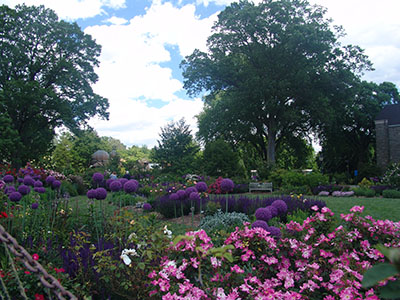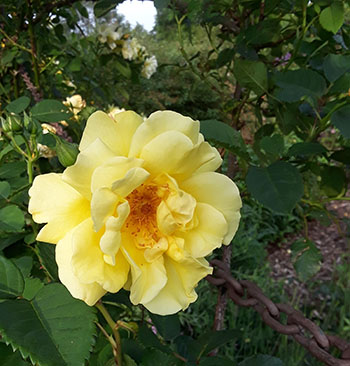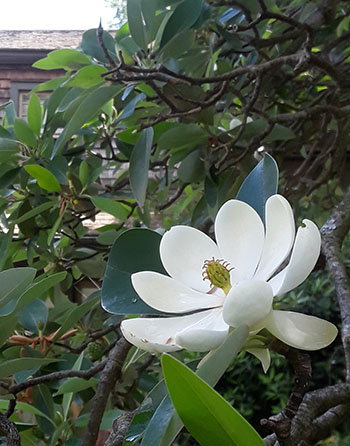
Plants of the Week: June 15

As magnolia and rose flowers bloom in unison, the Arboretum has become awash with color and divine aromas. Almost impossible to miss, the characteristic sweet scents of roses and magnolias are enchanting, soothing, and catching the attention of many passersby.
The Dean Bond Rose Garden has been stealing the show of late, a jamboree of plants in all shapes, types, scents, and colors. A host of superior rose selections mingle with choice perennials, bulbs, and flowering vines to create an incredible flowering composition that is endlessly fascinating to the eye and nose. Too impressive to visit just once, new roses come in and out of bloom and re-bloom throughout the summer, keeping things fresh and ever-intriguing.

One of my favorite roses on display is Rosa ‘Golden Gate’. This short climbing rose offers incredible ornamental value and disease resistance, making this a winning choice for the expert rosarian or casual home gardener. From May to August, R. ‘Golden Gate’ is festooned with golden yellow, semi-double flowers and a lovely citrusy scent. Following the prolonged bloom period, flowers become decorative hips in the fall, extending visual interest late into the year. The foliage is also quite handsome to my eye, large, semi-glossy in a rich tone of green.
This rose is ideal for growing up a trellis, pillar, or wall, which accentuate the graceful arching shape of this climber. This rose prefers full sun, and moist, well-drained soils, and will reach a mature size of 8 ft. tall by 4 ft. wide. To really make R. ‘Golden Gate’ pop, try pairing with a climbing purple clematis, such as Clematis ‘Venosa Violacea’ or Clematis ‘Polish Spirit’. Plan a visit to the Scott Arboretum today to see the rose garden in near-peak flower. photo credit: R. Payne-Meyer

A native magnolia whose scent has been recently ever-present around the Arboretum is the sweetbay magnolia, Magnolia virginiana. Highly fragrant flowers bloom intermittently throughout spring and summer, appearing in May lasting through July in abundance. M. virginiana has attractive glaucous leaves which are light green on top and silvery beneath. The small leaves of this M. viginiana seem aesthetically appropriate for this small-statured, somewhat shrubby tree. Plants may be evergreen, semi-deciduous, or fully deciduous with plants in the northern reaches of nativity exhibiting a fully deciduous quality.
M. virginiana is quite an adaptable plant, growing in sun or part shade in various soil types throughout the Coastal Plain, as far North as Long Island and as far south as Cuba, but rarely makes its way into the adjacent Piedmont forest composition. M. virginiana is known to be tolerant of poorly drained soils, an anomalous feature among the magnolia genus. It is often found growing in swampy areas, and as such is sometimes known as swamp magnolia.
The Scott Arboretum is home to the original ‘Henry Hicks’ cultivar of M. virginiana. This well-known selection is appreciated for its tight upright form, evergreen foliage, and intense aroma, all characteristic features of the variety australis within the M. virginiana species. The original M. virginiana var. australis ‘Henry Hicks’ can be in the Magnolia Collection, lovely and healthy as ever, and adorned with highly fragrant blooms. photo credit: R. Payne-Meyer

Magnolia grandiflora, the southern magnolia, is another native magnolia whose intense floral scent simply cannot be ignored. This large, broadleaf evergreen conjures imagery from the deep South, where these plants thrive and populate the landscape in abundance.
The large leaves of M. grandiflora are waxy dark green above, smooth and green to fuzzy brown on the underside, and occur in various shapes and sizes. Huge flowers (8”-12” in diameter) with a highly fragrant lemon scent are borne throughout the summer months, with 6-15 tepals (outer part of a flower) surrounding a large ornamental fruit. Fruits are woody and cone shaped, up to 8” long. The lustrous leaves and cones are both a favorite for holiday decor.
M. grandiflora becomes quite large with age, reaching up to 80 ft. tall with 50 ft. spread in optimal conditions, so give this plant some room to grow. Plants sometimes take on a rounded shape, and the low branching often obscures the trunk and adds to the space this tree occupies. For those who desire more room in their yard this tree can be limbed up into a more classic tree shape.
While this tree enjoys moist woodland soils, it can tolerate acid soils, wet and dry, sun and part-shade. M. grandiflora can be used as a noble specimen, in a grouping, or in a screen where its large and dense habit can be effectively put to use. Many lovely M. grandiflora specimens can be found around the BioStream, each offering characteristics slightly different than the next. I encourage you to explore this grouping and see which cultivar is your favorite! photo credit: M. Gissel





No Comments